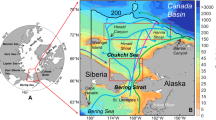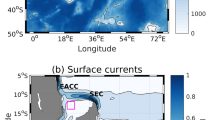Abstract
The response of phytoplankton to the Beaufort shelf-break eddies in the western Arctic Ocean is examined using the eddy-resolving coupled sea ice–ocean model including a lower-trophic marine ecosystem formulation. The regional model driven by the reanalysis 2003 atmospheric forcing from March to November captures the major spatial and temporal features of phytoplankton bloom following summertime sea ice retreat in the shallow Chukchi shelf and Barrow Canyon. The shelf-break warm eddies spawned north of the Barrow Canyon initially transport the Chukchi shelf water with high primary productivity toward the Canada Basin interior. In the eddy-developing period, the anti-cyclonic rotational flow along the outer edge of each eddy moving offshore occasionally traps the shelf water. The primary production inside the warm eddies is maintained by internal dynamics in the eddy-maturity period. In particular, the surface central area of an anti-cyclonic eddy acquires adequate light, nutrient, and warm environment for photosynthetic activity partly attributed to turbulent mixing with underlying nutrient-rich water. The simulated biogeochemical properties with the dominance of small-size phytoplankton inside the warm eddies are consistent with the observational findings in the western Arctic Ocean. It is also suggested that the light limitation before autumn sea ice freezing shuts down the primary production in the shelf-break eddies in spite of nutrient recovery. These results indicate that the time lag between the phytoplankton bloom in the shelf region following the summertime sea ice retreat and the eddy generation along the Beaufort shelf break is an important index to determine biological regimes in the Canada Basin.













Similar content being viewed by others
References
Aita MN, Yamanaka Y, Kishi MJ (2003) Effects of ontogenetic vertical migration of zooplankton on annual primary production using NEMURO embedded in a general circulation model. Fish Oceanogr 12:284–290
Aita MN, Yamanaka Y, Kishi MJ (2007) Interdecadal variation of the lower trophic ecosystem in the northern Pacific between 1948 and 2002, in a 3-D implementation of the NEMURO model. Ecol Model 202:81–94
Arrigo KR, van Dijken G, Pabi S (2008) Impact of a shrinking Arctic ice cover on marine primary production. Geophys Res Lett 35: L19603. doi:10.1029/2008GL035028
Campbell RG, Sherr EB, Ashjian CJ, Plourde S, Sherr BF, Hill V, Stockwell DA (2009) Mesozooplankton prey preference and grazing impact in the western Arctic Ocean. Deep Sea Res Part II 56:1274–1289
Garcia HE, Locarnini RA, Boyer TP, Antonov JI, Zweng MM, Baranova OK, Johnson DR (2010) World Ocean Atlas 2009. NOAA Atlas NESDIS 4:398
Grebmeier JM, Harvey HR (2005) The western Arctic Shelf–Basin Interactions (SBI) project: an overview. Deep Sea Res Part II 52:3109–3115
Grebmeier JM, Cooper LW, Feder HM, Sirenko BI (2006) Ecosystem dynamics of the Pacific-influenced Northern Bering and Chukchi Seas in the Amerasian Arctic. Prog Oceanogr 71:331–361
Grebmeier JM, Harvey HR, Stockwell DA (2009) The western Arctic Shelf–Basin Interactions (SBI) project, volume II: an overview. Deep Sea Res Part II 56:1137–1143
Grebmeier JM, Moore SE, Overland JE, Frey KE, Gradinger R (2010) Biological response to recent Pacific Arctic sea ice retreats. Eos Trans AGU 91:161–163
Hasumi H (2006) CCSR Ocean Component Model (COCO) version 4.0. Report of the Center for Climate System Research, Tokyo
Hill V, Cota G (2005) Spatial patterns of primary production on the shelf, slope and basin of the western Arctic in 2002. Deep Sea Res Part II 52:3344–3354
Hill V, Cota G, Stockwell D (2005) Spring and summer phytoplankton communities in the Chukchi and Eastern Beaufort Seas. Deep Sea Res Part II 52:3369–3385
Jin M, Deal C, Lee SH, Elliott S, Hunke E, Maltrud M, Jeffery N (2011) Investigation of Arctic sea ice and ocean primary production for the period 1992–2007 using a 3-D global ice–ocean ecosystem model. Deep Sea Res Part II. doi:10.1016/j.dsr2.2011.06.003
Kadko D, Pickart RS, Mathis J (2008) Age characteristics of a shelf-break eddy in the western Arctic and implications for shelf–basin exchange. J Geophys Res 113:C02018. doi:10.1029/2007JC004429
Kalnay E, Kanamitsu M, Kistler R, Collins W, Deaven D, Gandin L, Iredell M, Saha S, White G, Woolen J, Zhu Y, Chelliah M, Ebisuzaki W, Higgins W, Janowiak J, Mo KC, Ropelewski C, Wang J, Leetmaa A, Reynolds R, Jenne R, Joseph D (1996) The NCEP/NCAR 40-year reanalysis project. Bull Am Meteorol Soc 77:437–471
Kawasaki T, Hasumi H (2010) Role of localized mixing around the Kuril Straits in the Pacific thermohaline circulation. J Geophys Res 115:C11002. doi:10.1029/2010JC006130
Kishi JM, Kashiwai M, Ware DM, Megrey BA, Eslinger DL, Werner FE, Noguchi-Aita M, Azumaya T, Fujii M, Hashimoto S, Huang D, Iizumi H, Ishida Y, Kang S, Kantakov GA, Kim H, Komatsu K, Navrotsky VV, Smith SL, Tadokoro K, Tsuda A, Yamamura O, Yamanaka Y, Yokouchi K, Yoshie N, Zhang J, Zuenko YI, Zvalinsky VI (2007) NEMURO—a lower trophic level model for the North Pacific marine ecosystem. Ecol Model 202:12–25
Kishi MJ, Itoh S, Megrey BA, Rose KA, Werner FE (2011) A review of the NEMURO and NEMURO. FISH models and their application to marine ecosystem investigations. J Oceanogr 67:3–16
Lee SH, Whitledge TE, Kang S-H (2007) Recent carbon and nitrogen uptake rates of phytoplankton in Bering Strait and the Chukchi Sea. Cont Shelf Res 27:2231–2249
Manley TO, Hunkins K (1985) Mesoscale eddies of the Arctic Ocean. J Geophys Res 90:4911–4930
Mathis JT, Pickart RS, Hansell DA, Kadko D, Bates NR (2007) Eddy transport of organic carbon and nutrients from the Chukchi shelf: impact on the upper halocline of the western Arctic Ocean. J Geophys Res 112:C05011. doi:10.1029/2006JC003899
National Ice Center (2006) National Ice Center Arctic sea ice charts and climatologies in gridded format. Digital Media, National Snow and Ice Data Center, Boulder, Colorado
Nishino S, Shimada K, Itoh M (2005) Use of ammonium and other nitrogen tracers to investigate the spreading of shelf waters in the western Arctic halocline. J Geophys Res 110:C10005. doi:10.1029/2003JC002118
Nishino S, Itoh M, Kawaguchi Y, Kikuchi T, Aoyama M (2011a) Impact of an unusually large warm-core eddy on distributions of nutrients and phytoplankton in the southwestern Canada Basin during late summer/early fall 2010. Geophys Res Lett 38:L16602. doi:10.1029/2011GL047885
Nishino S, Kikuchi T, Yamamoto-Kawai M, Kawaguchi Y, Hirawake T, Itoh M (2011) Enhancement/reduction of biological pump depends on ocean circulation in the sea-ice reduction regions of the Arctic Ocean. J Oceanogr 67:305–314
Noh Y, Kim HJ (1999) Simulations of temperature and turbulence structure of the oceanic boundary layer with the improved near-surface process. J Geophys Res 104:15621–15634
Okkonen SR, Weingartner TJ, Danielson SL, Musgrave DL, Schmidt GM (2003) Satellite and hydrographic observations of eddy-induced shelf-slope exchange in the northwestern Gulf of Alaska. J Geophys Res 108:C23033. doi:10.1029/2002JC001342
Pabi S, van Dijken GL, Arrigo KR (2008) Primary production in the Arctic Ocean, 1998–2006. J Geophys Res 113:C08005. doi:10.1029/2007JC004578
Palmer MA, Arrigo KR, Mundy CJ, Ehn JK, Gosselin M, Barber DG, Martin J, Alou E, Roy S, Tremblay J-E (2011) Spatial and temporal variation of photosynthetic parameters in natural phytoplankton assemblages in the Beaufort Sea, Canadian Arctic. Polar Biol 34:1915–1928
Pickart RS (2004) Shelfbreak circulation in the Alaskan Beaufort Sea: mean structure and variability. J Geophys Res 109:C04024. doi:10.1029/2003JC001912
Popova EE, Yool A, Coward AC, Aksenov YK, Alderson SG, de Cuevas BA, Anderson TR (2010) Control of primary production in the Arctic by nutrients and light: insights from a high resolution ocean general circulation model. Biogeosciences 7:3569–3591
Spall MA, Pickart RS, Fratantoni PS, Plueddemann AJ (2008) Western Arctic shelfbreak eddies: formation and transport. J Phys Oceanogr 38:1644–1668
Steele M, Morley R, Ermold W (2001) PHC: a global ocean hydrography with a high-quality Arctic Ocean. J Clim 14:2079–2087
Sukhanova IN, Flint MV, Pautova LA, Stockwell DA, Grebmeier JM, Sergeeva VM (2009) Phytoplankton of the western Arctic in the spring and summer of 2002: structure and seasonal changes. Deep Sea Res Part II 56:1223–1236
Sumata H, Hashioka T, Suzuki T, Yoshie N, Okunishi T, Aita MN, Sakamoto TT, Ishida A, Okada N, Yamanaka Y (2010) Effect of eddy transport on the nutrient supply into the euphotic zone simulated in an eddy-permitting ocean ecosystem model. J Mar Syst 83:67–87
Ueno H, Crawford WR, Onishi H (2010) Impact of Alaskan Stream eddies on chlorophyll distribution in the North Pacific. J Oceanogr 66:319–328
Walsh JJ, Dieterle DA, Chen FR, Lenes JM, Maslowski W, Cassano JJ, Whitledge TE, Stockwell D, Flint M, Sukhanova IN, Christensen J (2011) Trophic cascades and future harmful algal blooms within ice-free Arctic Seas north of Bering Strait: a simulation analysis. Prog Oceanogr 91:312–343
Wang J, Cota GF, Comiso JC (2005) Phytoplankton in the Beaufort and Chukchi Seas: distribution, dynamics, and environmental forcing. Deep Sea Res Part II 52:3355–3368
Watanabe E (2011) Beaufort shelf break eddies and shelf–basin exchange of Pacific summer water in the western Arctic Ocean detected by satellite and modeling analyses. J Geophys Res 116:C08034. doi:10.1029/2010JC006259
Watanabe E, Hasumi H (2009) Pacific water transport in the western Arctic Ocean simulated by an eddy-resolving coupled sea ice–ocean model. J Phys Oceanogr 39:2194–2211
Weingartner T, Aagaard K, Woodgate R, Danielson S, Sasaki Y, Cavalieri D (2005) Circulation on the north central Chukchi Sea shelf. Deep Sea Res Part II 52:3150–3174
Zhang J, Spitz YH, Steele M, Ashjian C, Campbell R, Berline L, Matrai P (2010) Modeling the impact of declining sea ice on the Arctic marine planktonic ecosystem. J Geophys Res 115:C10015. doi:10.1029/2009JC005387
Acknowledgments
We would like to express our sincere gratitude to Dr. Shigeto Nishino at the Japan Agency for Marine-Earth Science and Technology (JAMSTEC) for his fruitful comments. This research is funded by Grants-in-Aid for Scientific Research (S) of Japan Society for the Promotion of Science (JSPS) JFY2010-2014, No. 22221003, “Catastrophic reduction of sea ice in the Arctic Ocean: its impact on the marine ecosystems in the polar region”. We also appreciate Dr. Naomi Harada at JAMSTEC for the project management. All numerical experiments were executed using the resources of JAMSTEC Earth Simulator version 2. The courteous comments and suggestions of anonymous reviewers markedly benefited the presented product.
Author information
Authors and Affiliations
Corresponding author
Appendix: Photosynthesis formulation in NEMURO
Appendix: Photosynthesis formulation in NEMURO
The NEMURO model configuration assumes that the photosynthesis of PS and PL is a function of nitrate NO3, ammonium NH4, and silicate Si(OH)4 concentration, water temperature T, light intensity I (Kishi et al. 2007). The formulation of gross primary production rate of PS (GppPS) and PL (GppPL) consists of nitrate, ammonium, silicate uptake terms (Nit, Amn, Sil, respectively), temperature-dependent term (Tmp), and light availability term (LA), and the biomass itself PS and PL as follows:
where the parameter values of maximum photosynthetic rate at 0 °C V maxs (0.7 day−1), V maxl (2.0 day−1), half-saturation constant for nitrate \(K_{\rm{{NO}_3}}\) (0.7 μM), ammonium \(K_{\rm{{NH}_4}}\) (0.2 μM), silicate \(K_{\rm{{Si(OH)}_4}}\) (1.15 μM), ammonium inhibition coefficient \(\Psi\) (1 \(\upmu \text{M}^{-1}\)), temperature coefficient for photosynthetic rate κ (0.0693 °C−1), optimum light intensity constant I opt (104.7 \(\text{W\,m}^{-2}\)), and Si:N ratio RSiN of 2 are all given based on Zhang et al. (2010). The nutrient uptake, Tmp, and LA terms are represented by traditional Michaelis–Menten, Q 10 relationship, and P–E curve formulation, respectively.
Rights and permissions
About this article
Cite this article
Watanabe, E., Kishi, M.J., Ishida, A. et al. Western Arctic primary productivity regulated by shelf-break warm eddies. J Oceanogr 68, 703–718 (2012). https://doi.org/10.1007/s10872-012-0128-6
Received:
Revised:
Accepted:
Published:
Issue Date:
DOI: https://doi.org/10.1007/s10872-012-0128-6




